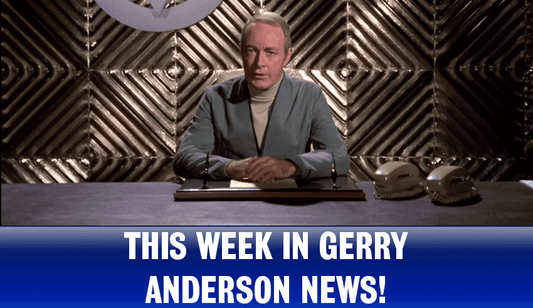Thunderbirds Thursday: A Third 1960s Thunderbirds Movie?
Share
Share

Thunderbirds may have only a brief lifespan on television between 1965 and 1966, yet it managed to spawn a pair of feature film spin-offs - Thunderbirds Are Go and Thunderbird 6. Unfortunately, neither managed to translate the success of the TV series to the big screen, yet a lingering possibility remains that, had they been winners, Thunderbirds may have strode on as an ongoing series of films.
This Thunderbirds Thursday, and on the week that Thunderbird 6 was first released in cinemas 56 years ago, we're speculating over what direction a third Supermarionation-based Thunderbirds movie may have taken!
Now, on the Big Screen!

For a Gerry Anderson series, Thunderbirds enjoys a rare dual life - a successful and much-loved television series, and a faltering pair of attempts to blast off into movies. Thunderbirds Are Go (1966) and Thunderbird 6 (1968) are valiant efforts to stretch Thunderbirds into becoming a sprawling multimedia behemoth. With so many merchandise and media opportunities exploited to great commercial and creative success beyond the TV series at their centre, the last field left for Century 21 Productions to conquer was the big screen.
Unfortunately, neither Thunderbirds film released in the late 1960s were huge successes. Any number of reasons can be postulated as to why they failed to take off with the kind of global reception that the James Bond films regularly received during this time, and which these films were evidently trying to emulate. However, the fact remains that the parting shot of the newly unveiled biplane as International Rescue's latest vehicle at the end of Thunderbird 6 ends Thunderbirds' all too brief run on TV and in the cinema. However, what if both films had enjoyed a far more positive reception? What if they had been global hits? What if their successes spawned a third film? And if so, what direction might that possible third Thunderbirds film have taken?
A Fresh Direction
Both Thunderbirds films are an encapsulation of the series' two primary genre tactics. Thunderbirds Are Go is the hard sci-fi blitz of the pair, an adventure that taps into the wonders of the space race with Zero X's first manned mission to Mars and ensuing disaster when its launch is sabotaged and its eventual arrival on Mars when it's terrorised by the menacing Rock Snakes. It's a hardware-driven spectacle of space-age adventure. By comparison, Thunderbird 6 is the lighter, calmer film of the pair, capturing the spy-fi craze of the 1960s with an adventure brimming with deceptive, slow-burn deceptive espionage.
Both movies still manage to traverse quirky territory. Thunderbirds Are Go features added star power with the inclusion of Cliff Richard and the Shadows through its surreal dream sequence endured by Alan Tracy, while Thunderbird 6 prioritises out-of-character depictions of the Tracy family, with Jeff Tracy unusually demanding of Brains to invent a new Thunderbird machine, and Parker unfairly treated as a punchline for much of the film. This is all enhanced further by the bizarre choice for the vehicle that would become Thunderbird 6 itself. If Zero X was purposefully envisioned with an eye on the all-important merchandise operation, Thunderbird 6 appears to have been created with the exact opposite mentality.

The philosophy at work in both of these films seems to have been creating the kind of adventures that weren't common territory for the TV series, the kind of adventures that were truly cinematic in scale and allowed for longer, grander stories to be told. Not the easiest of tasks to pull off when one of Thunderbirds' most defining aspects is that each episode functions as scaled-down cinematic epics in their own right.
Since Thunderbird 6 was designed to be the polar opposite to Thunderbirds Are Go, a convincing and sensible starting point for a third Thunderbirds film would be to be the polar opposite to Thunderbird 6. Coupled with the fact that neither Thunderbirds film places too much emphasis on International Rescue themselves, a third Thunderbirds film would surely benefit from trimming back on the excesses of those two initial efforts. Doing away with pop stars and biplanes, a third Thunderbirds film could have gone back to the series' roots and focused squarely on the Tracy's themselves in an adventure that positions them as the main cast instead of secondary players. A Thunderbirds film giving ample spotlight to the Thunderbird machines themselves is in short supply between Thunderbirds Are Go and Thunderbird 6. What a selling point then for a third film!
Diving Under the Sea
Given the outer space trailing of Thunderbirds Are Go and the world tour of Thunderbird 6, a third Thunderbirds film could distinguish itself all the more by offering an underwater-based scenario and the poorly represented Thunderbird 4 to take to the action. Indeed, oceanic settings were an increasingly rare sight post-Thunderbirds, but considering how advanced Century 21's special effects department was becoming by Joe 90 and The Secret Service (particularly with incredibly lavish interior production designs), a sea-based jeopardy for International Rescue's third big-screen adventure would be welcome territory.
A third Thunderbirds movie also provides opportunities for Derek Meddings' special effects unit to showcase fresh technological innovation for the world of Thunderbirds. Some new vehicular star along the lines of Zero X or Skyship 1 would allow for breath-taking special effects hardware in design and delivery. Sky and space-based settings had clearly been ticked off the list with the first two Thunderbirds films. A much more sea-based setting would test their filmmaking limits.

Underwater science fiction, whilst not rare, had the possible advantage of being underexposed in the 1960s compared to more traditional space-based adventure. And when other films had embraced such a setting, the results proved to be mostly fruitful. 1954's 20,000 Leagues Under the Sea won Academy Awards. 1961's Voyage to the Bottom of the Sea received a solid commercial reception and spawned a TV spin-off of the same name. Fast forward to the 1980s, and James Cameron would enjoy his own aquatic success with The Abyss. Audiences have proved to be warmly receptive to thrilling underwater adventure fantasy over the years. Why couldn't Century 21 Productions have tapped into that bubbling zeitgeist with their own underwater sci-fi adventure disaster epic?
Character-wise, both Thunderbirds films allow ample screentime for Lady Penelope and Parker and still manage to do a mostly successful job of embracing the ensemble nature of the Tracy family. The movie format feels much more suitable for Thunderbirds' large cast; all that a third film needed would be an imaginative core scenario that audiences could latch onto. Both Thunderbirds Are Go and Thunderbird 6 aren't devoid of creative prowess by any means, but their disjointed execution resulted in both films gaining a dispassionate reception from audiences. Clearly, something, or some things, about both films couldn't find a firm grip with a mass audience.
Lost Future
Alas, we can only speculate on what a third Thunderbirds movie may have entailed. There's plenty of other likely directions that a third or even more movies may have pursued, yet a sea-based adventure feels appropriately ample terrain for an enjoyable cinematic outing for International Rescue. Aquatic adventures quickly became enough of a rarity in the television series itself, so to shift the spotlight away from deep-space terror or spy-fi danger to giving the underused Thunderbird 4 and Gordon Tracy a solid adventure on the big screen would have been a welcome addition to the Thunderbirds canon.
To be the first to hear about the latest news, exclusive releases and show announcements, sign up to the Anderson Entertainment newsletter!




![Fireball XL5 World Space Patrol Technical Operations Manual [HARDCOVER BOOK] - The Gerry Anderson Store](http://gerryanderson.com/cdn/shop/files/fireball-xl5-world-space-patrol-technical-operations-manual-hardcover-book-290050.jpg?v=1711729272&width=720)



![Stingray Comic Anthology Volume Two – Battle Lines [HARDCOVER] - The Gerry Anderson Store](http://gerryanderson.com/cdn/shop/files/stingray-comic-anthology-volume-two-battle-lines-hardcover-107681.jpg?v=1738856151&width=720)
![Space: 1999 and UFO Book Bundle - Signed Limited Editions [HARDCOVER NOVELS] - The Gerry Anderson Store](http://gerryanderson.com/cdn/shop/files/space-1999-and-ufo-book-bundle-signed-limited-editions-hardcover-novels-589446.jpg?v=1718836845&width=720)
![Stingray WASP Technical Operations Manual Special Limited Edition [HARDCOVER BOOK] - The Gerry Anderson Store](http://gerryanderson.com/cdn/shop/files/stingray-wasp-technical-operations-manual-special-limited-edition-hardcover-book-991914.jpg?v=1732922875&width=720)
![Stingray: The Titanican Stratagem – Signed Limited Edition [HARDCOVER NOVEL] - The Gerry Anderson Store](http://gerryanderson.com/cdn/shop/files/stingray-the-titanican-stratagem-signed-limited-edition-hardcover-novel-129251.jpg?v=1740558711&width=720)






